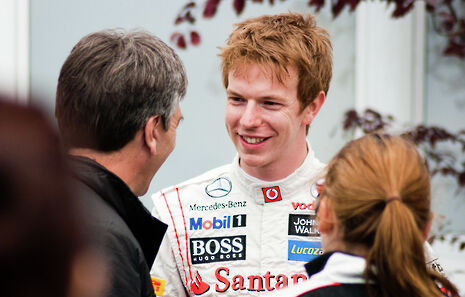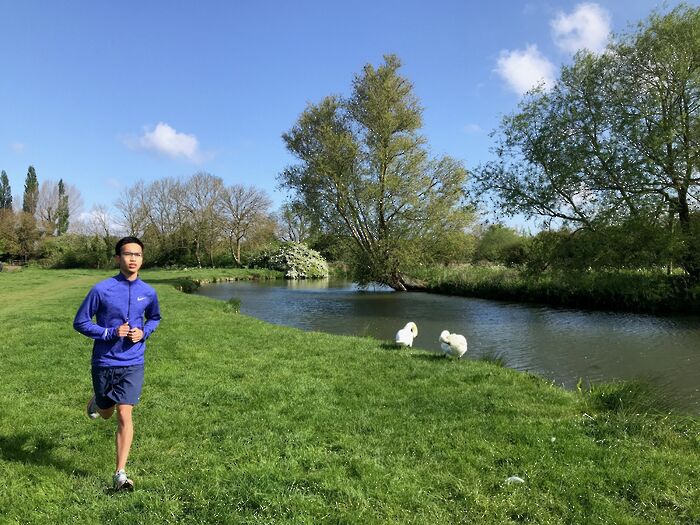From Cambridge to racecar extraordinaire – in conversation with Oliver Turvey
Finn Ranson chats with Formula E driver Oliver Turvey about his Cambridge days and how studying Engineering made him a better driver

“London was cool,” Oliver Turvey tells me when I ask him what has been his favourite track on the Formula E circuit. “The first two years we raced there, as a home race, it was one of the best. We go to some amazing cities.”
Oliver Turvey is one of those rarest of breeds. After graduating in Engineering at Cambridge, he went on to become a professional athlete – a race driver. He has since enjoyed a decorated career in an eclectic mix of single-seater disciplines, from the F3 series to competing in endurance events such as the famous 24 Hours of Le Mans. He is now one of 25 drivers in the innovative Formula E series, where the cars are powered by an electric battery.
“I had wanted to be involved since the beginning,” says Turvey, who was initially called up to drive for the NIO team in the last race of the Formula E’s first season in 2015. "The fact that they were promoting electric powertrains was interesting from my side.”
Although many in the motorsport community were sceptical when Formula E was announced, rapid technological advances mean the racing is bearing an increasingly close resemblance to competitions involving traditional petrol-powered cars. With its larger battery, the new Gen2 car introduced last year enabled drivers to complete an entire 45-minute race on one car. Increases in power have also pushed top speeds to the vicinity of 174 mph, just 20-30 mph slower than the average F1 car.
Formula E organisers have also used more novel means to attract audiences. Last season, the introduction of ‘Attack Mode’ rewarded drivers who drove through an ‘activation zone’ - usually a slower line through a corner - with an extra 25kW of power to use for a few laps.
“The Attack Mode added some strategy to the race because we didn’t have to pit stop anymore,” Turvey notes. “Formula E races are always close and challenging.”
Turvey’s enthusiasm for motorsport is a product of his upbringing. His father worked in the car industry and was a big motorsport fan. He took Turvey to Silverstone for the first time when he was five years old.
"There were some years where we didn’t have any budget to progress and we were just waiting and hoping for an opportunity.”
The pair subsequently started going to the Cumbria Kart Racing Club in Rowrah. Initially starting as a hobby, Turvey entered his first competitive race at the age of eight. Ultimately progressing to the British Kart Championships, he won his first national title at the age of twelve.
“That was the point where it became a lot more serious,” Turvey says. “After that I thought I could make a career out of it. I won my second British Championships when I was fifteen and I progressed from there. I was racing single-seaters when I was sixteen.”
It was a vital move up the ladder. But Turvey’s growing success was coming at a price.
“My parents weren’t able to support me without sponsors,” he explains. “I was very fortunate that I was sponsored by car manufacturers and an engine tuner as well.
“Motorsport is really expensive. You see so many big karters that don’t ever progress because they didn’t have the opportunities. I was aware of that from quite a young age… There were some years where we didn’t have any budget to progress and we were just waiting and hoping for an opportunity.”
But it was precisely because of all this uncertainty that Turvey’s parents encouraged him to work hard at school. Although he regularly missed Fridays through his teens to prepare for races at the weekend, he made sure his track commitments had little bearing on his studies. While karting was the sole focus for many of his peers, he and his parents saw it was essential to have a back-up as he pursued his precarious dream.
"Motorsport triggered my passion for engineering as well.”
And these two spheres became increasingly interlocked. “Me and my Dad literally did all the karting together,” notes Turvey. “I was maintaining the kart and working on it. That was one of the reasons why I was interested in engineering. I felt it was a good degree to do for motorsport.
“If the chances of becoming a professional driver were quite slim then maybe I would want to be a race engineer. Motorsport triggered my passion for engineering as well.”
In September 2005, Turvey began his degree in Engineering at Fitzwilliam College. Though his first week was not the typical cocktail of Cindies sweat and organised fun – “I actually raced in Freshers’ Week so I missed most of it,” he laughs – from then on the budding driver had a fairly normal induction into student life. With no funding to race, Turvey focussed on his studies and even dabbled in some rowing.
But at the end of first year everything changed. Turvey was asked to race for Formula BMW after a dropout halfway through the season. In the space of months he swapped racing on the Cam for racing on the track, and foliage for a second place medal, despite missing the first eight races of the 20-race long championship. He was the highest-placed Brit at the BMW World Finals in Valencia, finishing in sixth.
Turvey’s summer exertions earned him the prestigious McLaren Autosport BRDC Young Driver of the Year Award. “That was quite a turning point because it got massive recognition,” he says. “The likes of Jensen Button, David Coulthard had won that award, it’s one of the most prestigious out there. It helped me get sponsorship and to get a team for [the] following season.”
Turvey’s prize was to test McLaren’s F1 car. It would be the start of a fruitful relationship with the team, for which he is now entering his seventh year as a test driver.
Engineering’s notoriously exam-heavy third year, he tells me, was the toughest of all. By this time, alongside modules in aeromechanics, he was racing British Formula 3 – another gruelling 14-race circuit to which most drivers devote themselves fulltime. But with support from the University and Turvey’s own unique will to balance his two lives, he made it work. Indeed, he thrived, finishing second behind teammate Jaime Alguersuari.
“I think it worked quite well,” says Turvey, who received the first ever Full Blue for Motorsport in 2008. “When I was away racing I was focused on racing and it took my mind away. And when I was at university I was able to really concentrate on work.”
Unsurprisingly, rowing was off the agenda. Turvey’s down time was going for a run, training or going to the gym. He barely had time to spare for the University’s own karting scene, or Full Blue Racing. It may sound like a pretty monastic regime, but he was reaping the rewards as one of Britain’s most exciting young drivers.
“I was always an analytical driver,” Turvey reflects. “[But I came out of Cambridge] understanding things that have benefited me as a racing driver[,] to be able to work with engineers and be able to challenge and question them.”
“It’s not like I go to the engineers and tell them how to design a car,” he laughs. “It’s more about having that understanding to be able to give them the right feedback in terms of changes that they make and how they feel when I’m driving.”
In Fraser Masefield's words, the four-time F1 championship winner Alain Prost was famously dubbed ‘The Professor’. Oliver Turvey is very much ‘The Engineer’, a student of the aeromechanics he lives every day. With the huge amount of data teams can now compile for race strategy, perhaps that has never been more of an asset.
The sixth Formula E season kicks off on November 22 with a double-header in Ad Diriyah, Saudi Arabia. Turvey will be racing in his fifth campaign for NIO – and will be looking to bounce back from a 20th placed finish last year. As he reminds me, with the arrival of Mercedes and Porsche, the Formula will have eight manufacturers, the most of any series in motorsport. He knows this season will be harder than ever.
“The level of drivers is one of the highest in the world,” he says, with relish. “It’s going to be another exciting and super competitive season.”
- Updated, 25th October 2019: This article was updated to attribute a line to Fraser Masefield
 News / Caius mourns its tree-mendous loss23 December 2025
News / Caius mourns its tree-mendous loss23 December 2025 News / Clare Hall spent over £500k opposing busway 24 December 2025
News / Clare Hall spent over £500k opposing busway 24 December 2025 Comment / Yes, I’m brown – but I have more important things to say22 December 2025
Comment / Yes, I’m brown – but I have more important things to say22 December 2025 Interviews / Politics, your own way: Tilly Middlehurst on speaking out21 December 2025
Interviews / Politics, your own way: Tilly Middlehurst on speaking out21 December 2025 News / King appoints Peterhouse chaplain to Westminster Abbey22 December 2025
News / King appoints Peterhouse chaplain to Westminster Abbey22 December 2025









